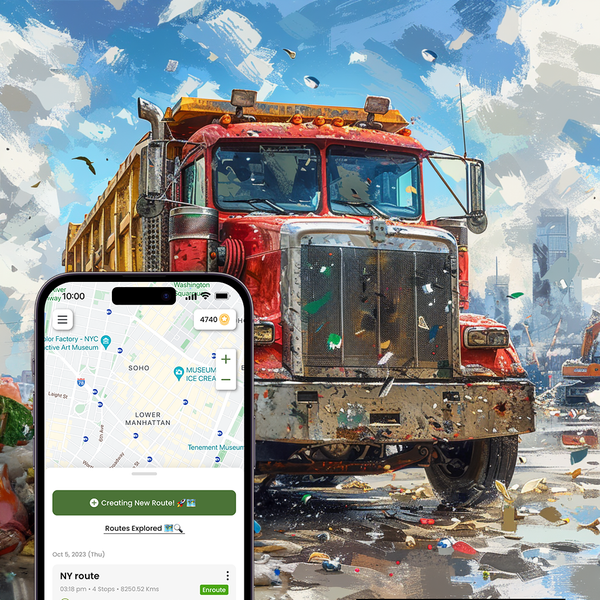Have you ever been stuck amongst the fleet of waste management vehicles crisscrossing the city in the chaotic ballet? This might seem like a usual scenario at first glance, but beneath the surface lies a financial strain that waste management companies navigate daily.
Thinking what that strain is about?
Here you go.
With an annual global solid waste amounting to $2.01 billion and with this, there is a rise in operational costs as well. The unnecessary usage of fuel costs, overtime payment to laborers because of delays, increasing wear and tear plus high maintenance costs eat all your profit margins.
So, the most pressing question here is - with thread-like profit margins, is there an effective way to deal with these high-rising operational expenditures?
Yes, Worry not! This comprehensive guide is all yours. Efficient and robust route planning and optimization software can significantly reduce these major operating costs.
Do you want to know how? Let’s delve deep into it and lessen the financial burden.
Understanding the Operational Costs Involved in Waste Management
Operational areas involved in waste collection processes are extensive, and so are the operational costs. Therefore, before delving into cutting waste management costs, we need to go through the multifaceted operational costs significantly impacting the waste management companies’ bottom line.
Have a look at the major costs and waste collection challenges involved:
- Fuel: The increasing fuel costs due to inefficient routes, the constant start-and-stop driving, and the high mileage routes can cause over 30% of waste budgets to be spent on diesel and gasoline. The higher fuel consumption resulting from higher operational costs can not only hamper you financially but also impact the environment adversely.
- Driver wages: The increasing shortages of skilled waste truck drivers plus the additional overtime paid due to inefficient waste collection routes can inflate labor costs. The constant strain on waste collection vehicles due to inefficient routes and extended mileage contributes significantly to maintenance costs.
- Maintenance: The frequent wear and tear and the consistent parts/mechanic repairs lead to substantial maintenance expenses. Not only this, the consistent breakdowns and repairs minimize the operational efficiency as well as interrupt the waste collection schedules
- Equipment Costs: With the rise in global warming sustainability requirements are also rising at the same pace. Purchasing or leasing waste trucks is expensive. Bins and containers also add up, especially if assets are misallocated.
Role of Efficient Route Planning in Cutting the Costs Involved
After going through the costs involved in waste management operations, don’t you think that there is a stringent need for a strong solution to curbing these rising expenditures?
Yes, you thought it right. And to your delight, we have one such intelligent and automated solution. A route planning and optimization software like DynoRoute minimizes manual intervention and transforms the landscape of waste management efficiency.
Have a look:
1. Intelligent routing algorithms:
The advanced route planning algorithms offered by the route planning software go beyond traditional waste management practices. This automated way of planning the routes has transformed the waste management industry's approach to operational efficiency.
It plans routes by analyzing real-time data, traffic patterns, and past route data. It dynamically optimizes the route and ensures that waste collection vehicles take the most efficient routes, resulting in minimized fuel consumption, limited wear and tear, and low maintenance cost eventually reducing overall operational expenditure.
2. Fuel efficiency at its core:
To optimize waste collection routes, reduced fuel consumption plays a vital role. An ideal route planning software can help strategically plan the waste collection routes. You can effortlessly plan the route considering traffic congestion, collection priorities, past route histories, as well as vehicle capacity. Route planning software ensures that each route is designed to reduce fuel consumption, contributing directly to significant cost savings.
3. Workforce optimization:
Workforce optimization can also be done using robust route planning software. Once the most efficient collection routes are planned, there is no need for extra laborers or laborers doing overtime, which eventually reduces operational costs. Also availability of the drivers can be tracked
By creating logical and efficient routes, the software minimizes the need for overtime due to inefficient routes. Skilled drivers can cover their designated routes more effectively, reducing labor costs and ensuring a balanced workload. This optimization ensures that your workforce operates at its best, leading to both cost savings and increased operational efficiency.
4. Real-time operational streaming:
DynoRoute provides real-time operational visibility, going beyond just route planning. It offers a live view of the entire waste collection process, ensuring that each vehicle is on the most optimized route. This level of operational transparency enhances reliability, customer satisfaction, and overall service efficiency.
5. Proactive maintenance strategies:
DynoRoute incorporates proactive maintenance strategies into its operations. By, optimizing routes to reduce strain on collection vehicles, significantly cuts down on maintenance costs. This isn't just about fixing vehicles; it's about preventing breakdowns, ensuring your fleet stays on the road consistently, and minimizing the financial strain associated with frequent repairs.
Benefits Beyond Cost Reduction
- Route optimization improves safety, satisfaction, and oversight.
- Fewer miles and balanced routes reduce driver fatigue and burnout.
- Asset tracking provides more visibility for compliance and auditing.
- Customer service is enhanced with accurate ETAs from traffic mapping.
- Optimized routes contribute to lower greenhouse gas emissions, aligning with sustainability goals.
- By minimizing fuel consumption, route planning aids in the conservation of valuable natural resources.
- Efficient routes enable waste management companies to adhere to schedules, ensuring timely collection.
- Reliable and timely services contribute to higher customer satisfaction levels.
What are the Best Practices to Follow to Lower Operational Costs Involved in Efficient Route Planning?
- Integrate efficient route planning software with predictive analytics.
- Map out routes based on real-time traffic data.
- Keep an eye on waste collection routes once optimized as traffic conditions can change anytime.
- Invest in training the employees so that you can make complete use of software capabilities
- Geographic information system (GIS) technology enables the analysis of spatial data, helping identify optimal routes.
- Leveraging historical data on collection patterns aids in predicting future demand and optimizing routes accordingly.
- Periodic assessments of route efficiency help identify areas for improvement and fine-tuning.
- Route planning systems should be adaptable to changes in waste generation patterns, city planning, or road infrastructure.
FAQs
How does route planning software contribute to reducing operational costs in waste management?
Route planning software optimizes waste collection routes by considering certain factors. For instance, real-time data analysis, recognizing traffic patterns, checking past route data, etc. This leads to minimized fuel consumption, limited wear and tear, and low maintenance costs, resulting in a significant reduction in overall operational expenditure.
Can route planning software help in workforce optimization?
Yes, route planning software like DynoRoute does help in workforce optimization. It creates logical and efficient routes, minimizes the need for overtime due to inefficient routes, ensures balanced workloads, and tracks the availability of drivers in real-time.
How does route planning enhance real-time operational visibility?
Route planning and optimization software provide real-time operational visibility by offering a live view of the entire waste collection process. It ensures that each vehicle is on the most optimized route, contributing to enhanced reliability, customer satisfaction, and overall service efficiency.
What role does proactive maintenance play in reducing costs in waste management?
Proactive maintenance strategies incorporated by route planning software like DynoRoute reduce strain on collection vehicles, leading to a significant cut in maintenance costs. This approach prevents breakdowns, ensures fleet consistency, and minimizes the financial strain associated with frequent repairs.
How does route optimization contribute to sustainability goals in waste management?
Route optimization in waste management contributes to sustainability goals by minimizing fuel consumption and reducing greenhouse gas emissions. The software ensures that routes are designed to be environmentally responsible, aligning with broader sustainability objectives.
Conclusion
Effective route planning plays a critical role as we traverse the intricate terrain of waste management operations. It not only reduces expenses but also sets the stage for waste management techniques that are efficient, sustainable, and ecologically friendly in the future. Accept the power of route planning and make the most of your trip towards an ecosystem for waste management that is both affordable and cleaner.








